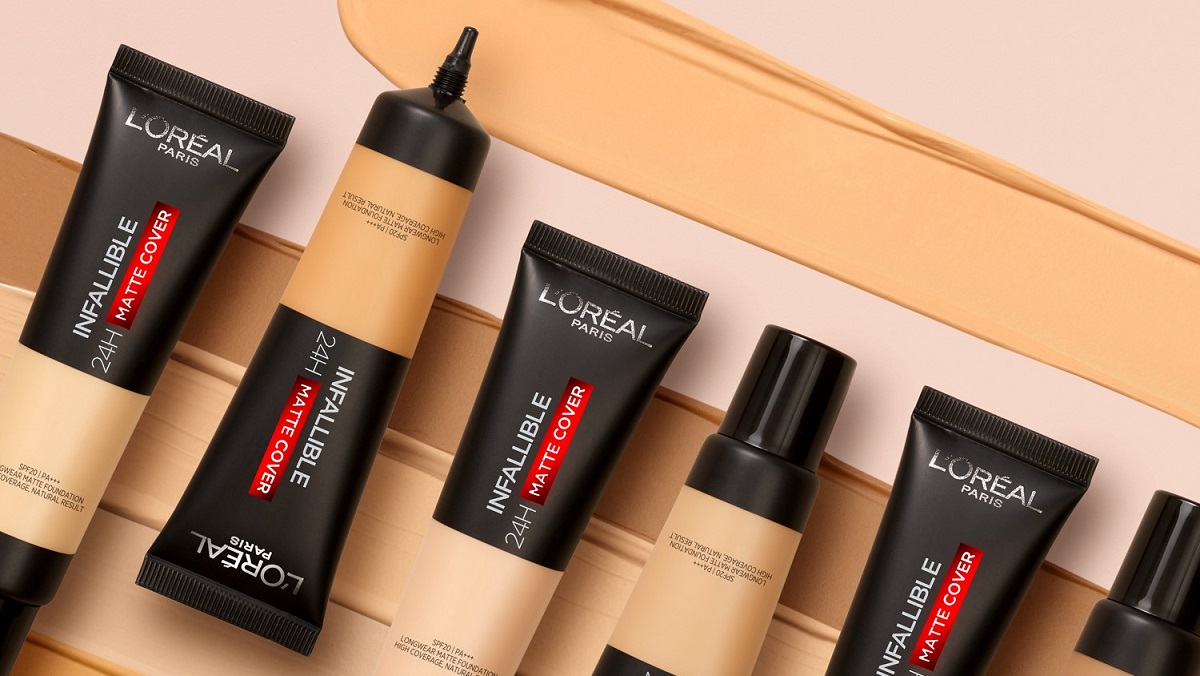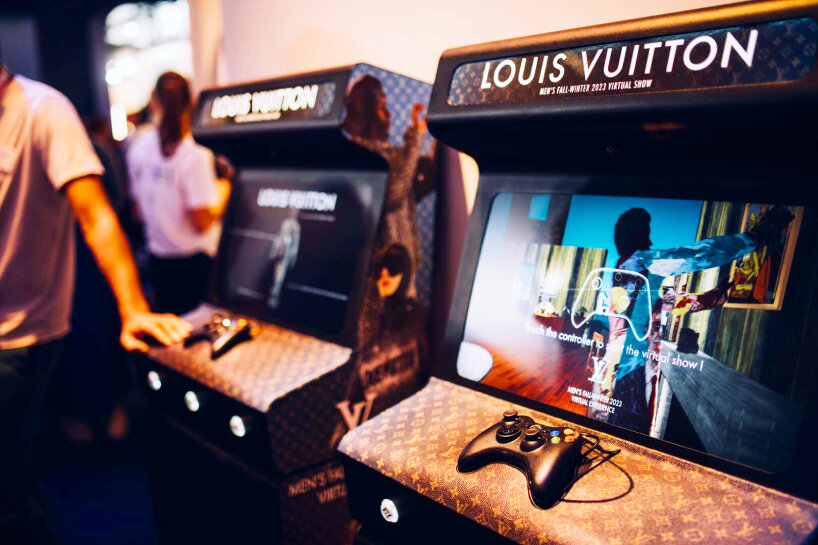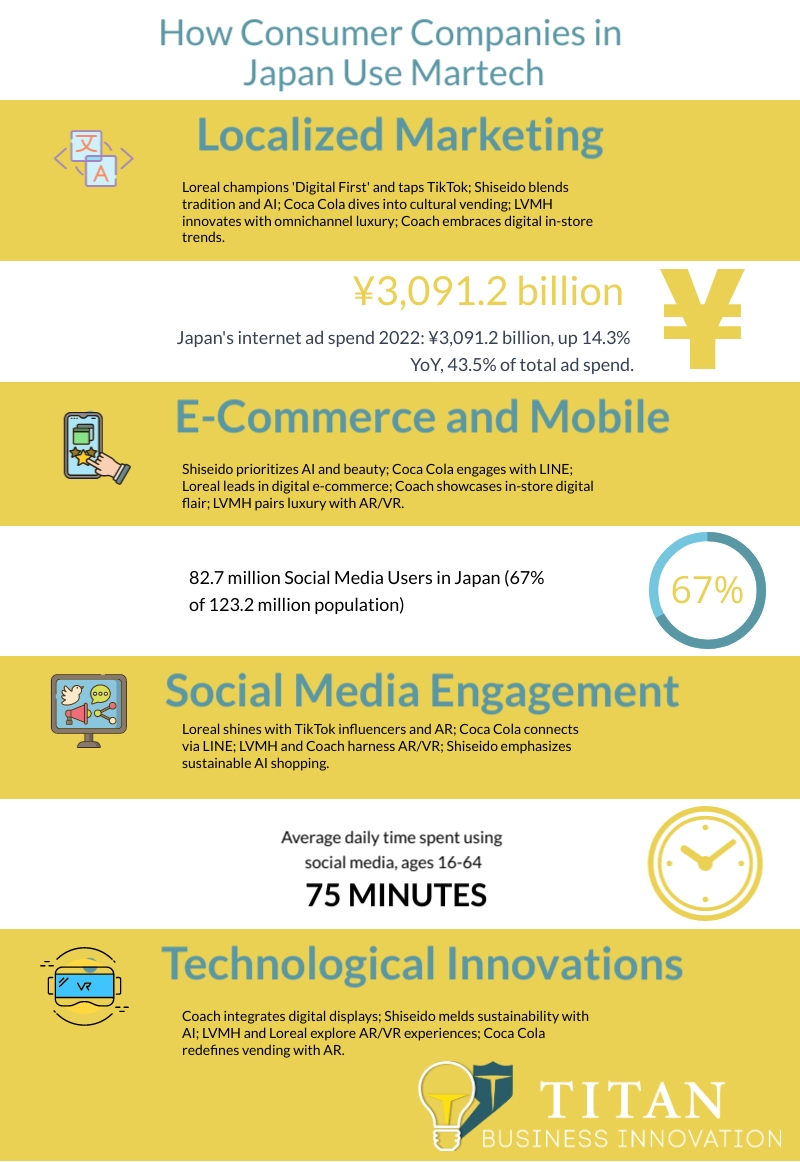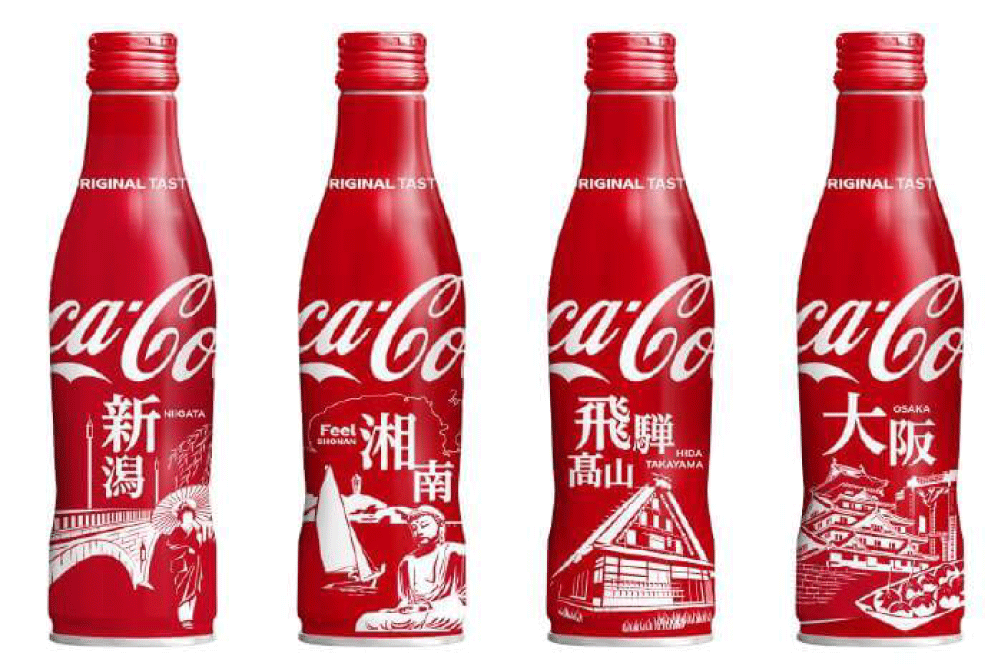Leading consumer brands Coca-Cola, LVMH, L'Oréal, Shiseido, and Coach adapt and innovate in Japan, blending technological advances with deep cultural understanding to engage the sophisticated Japanese market.
Japan’s ever-evolving consumer market requires a sophisticated blend of technology and cultural understanding. This analysis delves into the unique approaches of five leading consumer companies – Coca-Cola, LVMH, L’Oréal, Shiseido, and Coach – comparing and contrasting their Martech strategies in Japan.
Localized Marketing Strategies
Coca-Cola
Coca-Cola taps into Japanese culture through localized advertising. They utilize seasonal themes, such as cherry blossom designs in spring and leverage endorsements from local celebrities. Their strategy reveals a deep understanding of Japanese sentiments, crafting campaigns that resonate with local values and traditions.
LVMH
LVMH has taken significant strides in aligning its branding with the Japanese market’s luxury and exclusivity preferences. The company’s digital strategy aims to enhance customer experience through the seamless integration of online and offline channels, referred to as omnichannel. They have established teams in Japan and France to support the digital transformation of 38 brands. With a focus on the unique challenges in Japan, including factors like the popularity of LINE and distinct purchasing behaviors, LVMH’s approach blends global strategies with local needs.
L’Oréal
L’Oréal embraces digital transformation as a revolution, completely reshaping ways of living, consuming, and working. Viewing this transformation as an opportunity to forge new relationships based on innovation, relevance, transparency, and trust, L’Oréal has become a ‘Digital First’ company. They are developing new products and services that respond to changing consumer expectations, going beyond e-commerce to create special relationships with consumers, partners, and employees.
Shiseido
Shiseido draws upon its deep understanding of Japanese culture, focusing on beauty, heritage, and innovation. By aligning with local traditions and sensibilities, Shiseido is able to maintain strong connections with Japanese consumers, reinforcing its local appeal.
Coach
Coach builds upon fashion and style to create connections with the Japanese market. Through collaborations with Japanese designers and engagement with local fashion trends, Coach showcases a nuanced understanding of the local consumer’s desires and expectations.
Comparison:
Though all five prioritize e-commerce, they focus differently: Coca-Cola innovates with vending machines, LVMH creates a luxury online experience, L’Oréal shifts towards social commerce, Shiseido leverages AI personalization, and Coach emphasizes mobile optimization.
E-Commerce and Mobile Optimization
Coca-Cola
Coca-Cola’s e-commerce innovations include state-of-the-art vending machines equipped with touch-screen interfaces, AI-powered recommendations, and cashless payment options. This approach reflects a fusion of traditional vending experiences with modern technological enhancements, offering an engaging consumer interaction.
LVMH
LVMH’s digital strategy focuses on creating a seamless online luxury shopping experience. This approach aims to create a seamless purchasing experience, merging online and offline platforms. The company’s focus on promoting omnichannelization reflects the growing importance of a hybrid shopping experience, driven by pandemic-related shifts in consumer behavior.
L’Oréal
L’Oréal has developed e-commerce solutions that transform their websites into new experiential platforms. The move towards online purchasing is accelerating, with partnerships created with major e-commerce platforms like Amazon and Alibaba. In markets like China, more than one in every two products is sold online, reflecting a trend increasingly influenced by social media networks, shaping the future of beauty as ‘social commerce.’

Shiseido
Shiseido emphasizes a smooth e-commerce journey, utilizing AI-driven personalization. By analyzing consumer behaviour, they tailor recommendations, enhancing the online shopping experience.
Coach
Coach’s mobile optimization includes user-friendly design, easy navigation, and integration with popular Japanese e-commerce platforms. Their approach facilitates effortless browsing and purchasing on mobile devices.
Comparison:
Though all five prioritize e-commerce, they focus differently: Coca-Cola innovates with vending machines, LVMH creates a luxury online experience, Shiseido leverages AI personalization, and Coach emphasizes mobile optimization.
Engaging Through Social Media and Influencers
Coca-Cola
Coca-Cola employs platforms like LINE and Twitter to engage in real-time interactions with consumers. These initiatives foster a sense of community and connection, allowing the brand to maintain relevancy and presence within the dynamic Japanese social media landscape.
LVMH
LVMH places emphasis on collaborations with local e-commerce platforms and information exchange within the group. The company also focuses on open communication between different brands (maisons) and a clear understanding of the Japanese market’s specific needs. Strategic partnerships with Japanese influencers further enhance brand engagement.
L’Oréal
L’Oréal’s digital transformation engages brand ambassadors and influencers celebrating beauty in all its diversity. They work with individuals who share their spirit of dialogue, transparency, and honesty, leveraging social networks like YouTube, Weibo, TikTok, and Instagram to open up the world of beauty. They have also recruited over 2,500 digital experts and trained several thousand employees in digital tech to drive this transformation.
Shiseido
Shiseido builds a strong community through social media platforms, encouraging user-generated content and direct interactions. Their emphasis on beauty tutorials, product demonstrations, and skincare advice fosters loyalty and connection.
Coach
Coach leverages social media for collaborations with local artists, special offers, and limited-edition collections. They engage with consumers through contests, exclusive previews, and live-streamed events.
Comparison:
All five companies leverage social media and influencers, but in distinct ways: Coca-Cola fosters real-time interactions, LVMH emphasizes collaborations and strategic partnerships, L’Oréal engages brand ambassadors and celebrates beauty diversity, Shiseido builds a strong community through tutorials and direct interactions, and Coach creates connections with local artists and exclusive events.
Technological Innovations
Coca-Cola
Coca-Cola’s innovations extend to AR and personalized vending experiences, reflecting their commitment to leveraging cutting-edge technology to enhance consumer engagement.
LVMH
LVMH’s approach to technology includes exploration of AR and VR for virtual try-ons and alignment of global and local digital strategies with their overall vision. Investment in technology focuses on not just infrastructure but also organizations and human resources, looking beyond tools to achieve broader goals.

L’Oréal
L’Oréal offers ultra-personalized care using voice commands and augmented reality for virtual try-ons. Their commitment to building a trustworthy digital economy focuses on transparency and ethical practices, making information about product composition, manufacturing conditions, social, and environmental impacts available to all.
Shiseido
Shiseido utilizes technology for sustainability communication and seamless online shopping. They employ digital channels to share their sustainability initiatives and use AI to enhance online shopping with personalized recommendations.
Coach
Coach employs in-store digital kiosks and interactive displays, bridging the gap between online and offline shopping. Their innovative technology enhances the in-store experience, offering consumers convenience and personalized interactions.
Comparison:
The technological innovation strategies also vary among the five companies: Coca-Cola focuses on AR and personalized vending experiences, LVMH explores AR and VR for virtual try-ons, L’Oréal offers ultra-personalized care using voice commands and augmented reality, Shiseido utilizes technology for sustainability communication and seamless online shopping, while Coach employs in-store digital kiosks and interactive displays.
Coca-Cola, LVMH, L’Oréal, Shiseido, and Coach have forged unique paths in utilizing Martech to engage the sophisticated Japanese market. From L’Oréal’s hyper-connected playground to LVMH’s seamless omnichannel strategy, these brands are at the forefront of blending technology, human insight, and cultural agility to enhance the brand experience. The multifaceted nature of their strategies reveals the complex dynamics of the Japanese consumer environment, offering valuable insights for marketers looking to navigate this unique and highly competitive landscape.


